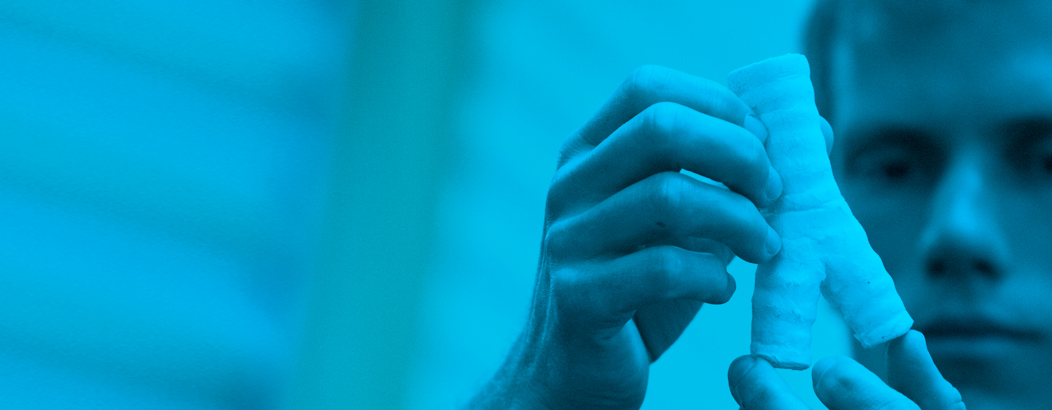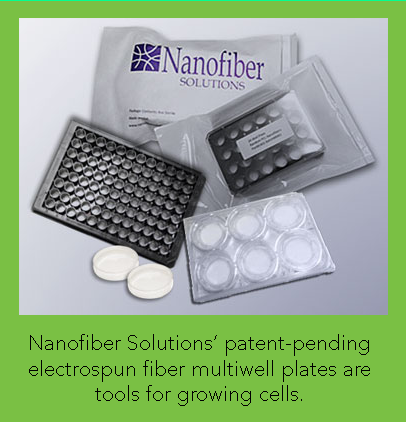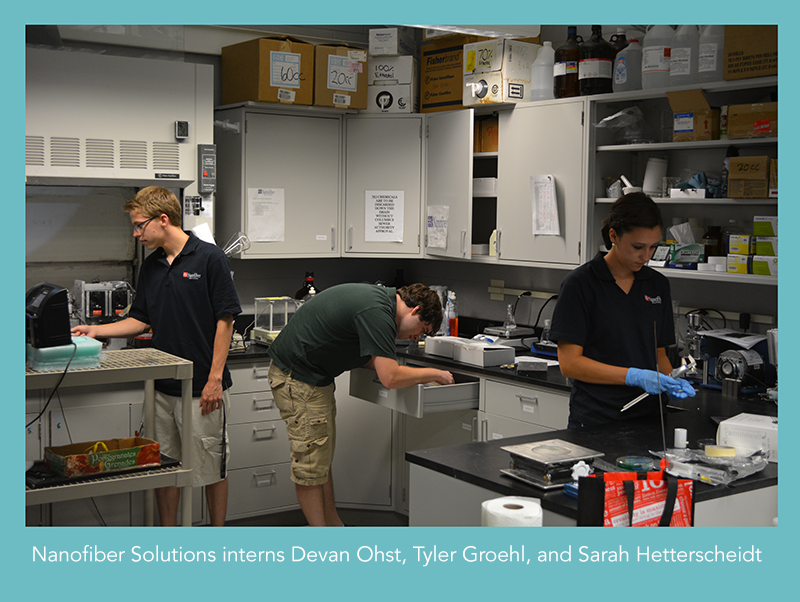Nanofiber Solutions Contributes to Ohio’s 20% increase in Biotech Jobs and to Attracting Students to Biotech Business Opportunities
 Ohio has seen about a 20 percent growth in the biotech sector jobs over the last ten years. Some of these came from established corporations, but many came from new businesses like Nanofiber Solutions.
Ohio has seen about a 20 percent growth in the biotech sector jobs over the last ten years. Some of these came from established corporations, but many came from new businesses like Nanofiber Solutions.
The idea for Nanofiber Solutions’ nano-scaffolding took hold with co-founder Jed Johnson when he was a PhD student in the Materials Science and Engineering department at The Ohio State University.
As part of his thesis, Johnson was developing subculture devices in collaboration with neurosurgeons at the university, looking specifically at brain tumors. The surgeons that Johnson was working with wanted a way to model how cancer spreads that was more realistic than studying the cells in a flat Petri dish.
“I was working on electrospinning, a technology which created nanofibers, each one smaller than 100 human hairs,” Johnson said. “As part of my research I was able to align the fibers to form a parallel array, like the lines on a piece of paper appear.”
The neurosurgeons were able to put tumor cells on the nano-scaffolding and study how the cancer migrates. Johnson’s research was awarded grants from the National Institute of Health and the National Science Foundation. He and co-founder John Lannutti, PhD founded Nanofiber Solutions in 2009, and brought on a serial entrepreneur, Ross Kayuha, as CEO.
“When I received my PhD in 2010,” Johnson said, “we were ready to go.”
Nanofiber Solutions provides medical devices for research and tissue engineering.
Nanofiber Solutions’ patent-pending electrospun fiber multiwell plates are tools for growing cells.
Surgeons put tumor cells on these plates to create an environment that more closely mimics how cancer cells migrate in the human body. It’s like the difference between walking across a flat, smooth surface versus climbing over a pile of rocks and logs. Treatment therapies have different effects, depending on how the cancer moves.
 “From there, we learned that all types of cells grow really well on our nanofiber scaffolding,” Johnson said. “If you are a cancer researcher looking at drug resistance or a stem cell biologist looking at how stem cells differentiate into different tissue, you can use our tools. Pharmaceutical companies use the nanofiber plates to do high volume drug discovery.”
“From there, we learned that all types of cells grow really well on our nanofiber scaffolding,” Johnson said. “If you are a cancer researcher looking at drug resistance or a stem cell biologist looking at how stem cells differentiate into different tissue, you can use our tools. Pharmaceutical companies use the nanofiber plates to do high volume drug discovery.”
Now, Nanofiber Solutions is translating everything the company has learned about nanofiber scaffolding into regenerative medicine, creating devices for blood vessel and trachea replacement, intestinal scaffolds, vascular grafts, and skin and wound healing.
“We can implant these materials into the body to replace damaged organs or sometimes congenital birth defects,” Johnson said. “If you get a vascular graft made of our material, in three to four months, it will resorb or biodegrade and the body will heal. We give the body the right environment to heal itself, and it will do what it is designed to do.”
“There is a tremendous amount of basic lab testing and mechanical characterization of the nanoscaffolds that is needed for these tissue engineering solutions,” Johnson said.
And that’s where Nanofiber Solutions—a company started in a university lab by a university graduate student—is creatively reaching out to engage more students as interns in scientific discovery and innovation.
Nanofiber Solutions provides meaningful internships for Ohio State and high school students.
“Our interns are typically engineers,” said Johnson, who maintains strong connections with the Materials Science and Engineering department at Ohio State.
“Most of them are biomedical engineers. They are generally undergraduate students, although we have a couple of graduate students, and even have several high school students in the lab,” he said. “We train them on projects, teach them safety procedures, and give them stand-alone projects to complete.”
The interns operate independently, collecting and analyzing data, preparing charts and graphs, and presenting their findings.
“I very much view this as a win-win,” Johnson said. “We aren’t hosting these students out of charity. We take their work seriously. They are learning and we are getting something from their work.”
Most college students today need the internship experience to get a job. “There aren’t enough internships to go around,” Johnson said. “We provide a really high quality hands-on internship experience. Many companies have processes and procedures that are too large for an intern to get their hands around. We have the environment to give them a meaningful experience.”
Nanofiber Solutions is a resident in SpringBox Labs, right up the street from Ohio State.
“We have great access to the talent pool,” Johnson said. “There are buses that bring students right by our building. It’s perfect to pull talented students from there. We’re flexible with the work schedule, so they can take classes in the morning and work here in the afternoon.”
At Nanofiber Solutions, motivation is the most important trait in a successful intern.

“I’m not too concerned with their background,” he said. “That is especially true with the high school students who may only be in preliminary chemistry and physics. But even with the college interns, I’m not concerned about their degree, but where their heart is. What are they interested in and passionate about? Are they curious, willing to research or look things up on their own without me spoon-feeding them? Can they think independently?”
The interns’ willingness to learn has been impressive.
“This is my specific way of giving back,” Johnson said. “If we can mentor some of these students, and give them a real world experience, they can begin to see what is possible. When kids realize what they can do by combining engineering and medicine, it’s really neat.”

